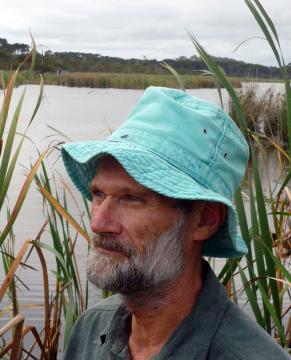Introduction
Perry Lakes, comprising West Lake (ca 5.2ha) and East Lake (ca 6.9ha) are two small semi-permanent freshwater wetlands located within the western suburbs of Metropolitan Perth, Western Australia. This thesis examines wetlands and their underlying hydrology at two scales:
- Individual wetland level (Perry Lakes)
- Regional level (the local unconfined aquifer)
Genesis for the project was based on the theoretical research into lake-aquifer interaction undertaken by Dr Lloyd Townley and Simon Nield (Nield et al 1994). They were able to demonstrate theoretically that lakes within unconfined aquifers are not simply passive windows to the water table. Rather, they induce complex families of lake-aquifer interactions or ‘flow regimes’. Using dimensionless ratios of simple physical characteristics such as lake and aquifer dimensions and hydrologic parameters such as recharge and evaporation they were able to model these in plan and 2D vertical section. Regional field work on the Swan Coastal Plain (Townley et al 1993a&b) using mass, solute and isotopic methods provided an initial field validation of the theoretical concepts. The underlying foundation for such modelling is knowledge of the lake water balance. The concept of a water balance is deceptively simple. In practice however it presents exceedingly difficult field problems (Winter 1981).
Perry Lakes were chosen because they represented an extremely dynamic system, forced artificially by storm water inputs and artificial summer lake level maintenance. The lakes (and the surrounding regional groundwater system) had suffered from declining water levels for several decades and the Town of Cambridge as wetland managers were supportive of any research into the lakes which might provide an understanding of the water level problem and provide long term management solutions to it. It was understood that the groundwater fluxes into and out of the lakes would be particularly difficult to measure. The proposed solution was to use integrated mass, solute and isotopic balances as suggested by Townley et al (1993b) which in combination would allow the elusive groundwater flux components to be teased out. A theoretical framework for this had been established (Townley et al 1993a) but again a practical field validation had not been demonstrated. These balances and the resulting rigorous measurement of their groundwater components represents the single most important achievement of the project.
An added complexity of the isotopic balance was the requirement to quantify isotopic exchange parameters relating to lake evaporation and atmospheric vapour. While these could be estimated using empirically derived general equations, a more rigorous approach was proposed in which they would be experimentally determined specifically for Perry Lakes. Evaporation was also flagged as a water balance component that would be extremely difficult to measure accurately. The proposed solution was to perform a thermal balance in which all the thermal components would be measured with the difference being the heat used to evaporate water from the lake surface. Early field data however suggested that in extremely shallow lakes, sediment heat flux (a component usually ignored) was potentially of equal importance. Faced with two unknowns in the thermal balance a direct measurement solution in the form of a floating evaporation pan was devised to measure evaporation independently. Determining evaporation independently then permitted a number of empirical evaporative techniques to be tested and calibrated specifically for Swan Coastal Plain conditions along with realistic monthly pan to lake coefficients for the Bureau of Meteorology Class A pan at Perth Airport and a Class A pan operating adjacent to Perry Lakes. The importance of transpiration from emergent wetland vegetation was also unknown. Again separate field experiments were devised to quantify its contribution to the water balance.
The practical problem of declining water levels in Perry Lakes required regional hydrologic data far more detailed than that available from government sources. Comprehensive regional water table monitoring and domestic bore mapping programs were undertaken in tandem with the detailed balance work at Perry Lakes. It was also necessary to determine local aquifer characteristics through pump and other tests. The result was a comprehensive seasonal picture of the complex lake-aquifer flow regimes induced around and between the two lakes as a result of seasonal forcing from storm water, top up and depression of the water table from bore extraction. The regional work allowed estimates of the regional water balance to be computed. These strongly suggested that bore extraction and climate change were both significant factors in the declining water levels at Perry Lakes. The study concludes with possible management options.
Ultimately the three detailed balances (mass, solute and isotope) became the focal points of the study (and hence the basis of the thesis title). The integrated balances proved unequivocally what hydrologists and environmentalists have long suspected. Using wetlands as convenient storm water depositories fundamentally modifies the way a water table lake operates. Natural groundwater discharge into the lake is reduced (and often completely suppressed) while recharge from the lake back to the unconfined aquifer is increased.
References
Nield, S. P., Townley, L. R. & Barr, A. D. 1994: A framework for quantitative analysis of surface water-groundwater interaction: flow geometry in a vertical section. Water Resources Research 30(8), 2461-2475.
Townley, L. R., Turner, J. V., Barr, A. D., Trefry, M. G., Wright, K. D., Gailitis, V., Harris, C. J. & Johnston, C. D. 1993a: Interaction between lakes, wetlands and unconfined aquifers. CSIRO Division of Water Resources Consultancy Report 93/1.
Townley, L. R., Turner, J. V., Barr, A. D., Trefry, M. G., Wright, K. D., Gailitis, V., Harris, C. J. & Johnston, C. D. 1993b: Interaction between lakes, wetlands and unconfined aquifers. In: Wetlands of the Swan Coastal Plain Volume 3, Environmental Protection Authority of Western Australia and Water Authority of Western Australia.
Winter, T. C. 1981: Uncertainties in estimating the water balance of lakes. Water Resources Bulletin 17(1), 82-115.

